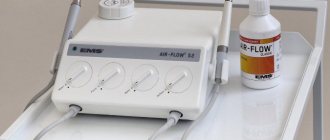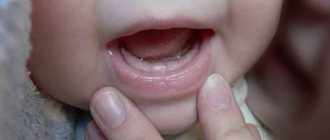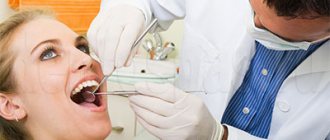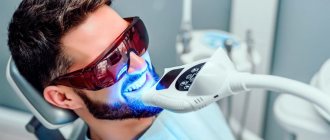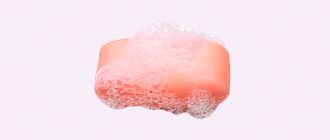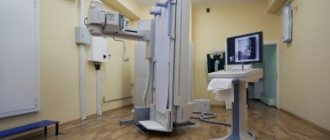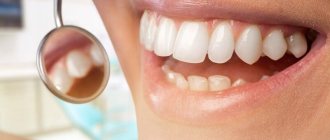The dentist's office, as well as other rooms where complex medical procedures are performed, must be perfectly clean and highly sterile. This is ensured by a number of measures to maintain and restore order. One of the most important activities of this kind is general cleaning in the dental office , which includes thorough washing and complete disinfection of all surfaces. Its regular implementation allows you to maintain asepsis in dentistry, and this makes treatment safer and more successful.
GENERAL CLEANING IN DENTISTRY - RULES FOR WASHING AND DISINFECTION
Any cleaning in dentistry must comply with the standards described in special documents. Only then will it help achieve the desired cleanliness. Here are the main rules for general cleaning:
- in the dental office only specially designated equipment is used (they do not clean other rooms with it);
- in normal times, buckets, mops, etc. are stored in a separate place (this could be, for example, a special cabinet);
- for cleaning work it is necessary to wear special clothing;
- all surfaces are washed in a certain sequence - first the ceiling, walls, then windows and elements of the heating system, then furniture and equipment and finally floors;
- General cleaning of surgical dental offices is carried out weekly, and therapeutic and orthopedic - monthly.
Rules for the use, processing and storage of cleaning tools
Sanitation of the premises is carried out using metal and plastic buckets, mops, brushes, and sterile rags. Cleaning equipment should be separate for each type of dental office, as well as for routine and general cleaning. Mixing or interchange of items is not permitted. To prevent accidental misuse, equipment must be marked with indelible writing, color coding, or other visible means.
After use, all cleaning equipment is thoroughly treated with disinfectant solutions, then washed in hot running water and dried. It is advisable to use textile napkins once, but if this is not possible, they are washed in powder with boiling water.
Cabinets for storing cleaning equipment should be separate, in accordance with which office and for what type of cleaning certain items are used, and located outside the medical offices, in specially designated rooms.
GENERAL CLEANING IN DENTISTRY. WHAT DO YOU NEED TO WORK?
To properly perform general cleaning in a dental office, you will need the following set of tools and equipment:
- buckets (4 pcs. - two each for the floor and everything that is above the floor);
- two mops (one “floor”, the second – for walls and ceilings);
- plenty of clean and sterile (disposable) wipes (traditionally, rags are used instead).
You will also need good detergents and disinfectants (DS). The latter must effectively combat pathogens, but at the same time not exhibit a strong toxic effect on people. DS with a detergent component are especially convenient; then washing and disinfection can be performed simultaneously, in one go. Many people prefer disinfectants that do not require rinsing - this also saves the cleaner’s time.
CARRYING OUT GENERAL CLEANING IN DENTISTRY IN STAGES
Over the years of development of medicine, the most convenient and effective procedure for carrying out cleaning and disinfection work has been developed. It is described in regulatory documentation as an algorithm for carrying out general cleaning, and it is highly undesirable to deviate from it. In dentistry it works like this:
- clean particularly dirty surfaces from dust and stains using a regular detergent;
- wipe all surfaces with napkins generously soaked in DS solution;
- disinfect the room with ultraviolet light (you need to turn on the bactericidal lamp for an hour);
- after UV irradiation, wash off the disinfectant solution from surfaces with sterile or disposable wipes and clean water;
- turn on the bactericidal lamp again (for half an hour to an hour).
Safe chemistry
Disinfection of dental instruments is carried out using physical methods or chemical solutions.
The choice of the former involves the use of boiling. The items are immersed in hot distilled water and boiled for thirty minutes. To enhance the effect, 2% sodium bicarbonate can be added to the boiling liquid. Sometimes the method of exposure to saturated steam, the temperature of which is 110 degrees Celsius, is used. To destroy all pathogenic organisms, the exposure time should be at least 20 minutes. Many large clinics purchase an air sterilizer. In it, disinfection is carried out by exposure to dry hot air, the temperature of which is 120 degrees Celsius. The time of one session is 45 minutes.
The choice of physical disinfection methods has a number of limitations. Such processing of tools provokes the development of metal corrosion, sharp parts quickly become dull, and mirror elements become dull. Only clean instruments without protein or fat contamination can be loaded into the air sterilizer. Therefore, you first have to use a manual processing method. This increases the complexity of the process and time costs.
Chemical disinfection in dentistry is disinfection, which is carried out using a disinfectant (chemical solution). This method is actively used by dental clinics. There is a list of funds approved by the Department of State Sanitary and Epidemiological Surveillance of the Ministry of Health of the Russian Federation. Their use is strictly regulated. Methodological guidelines have been developed and implemented. Using them, medical workers prepare solutions and use them to disinfect work surfaces and instruments.
Chemical solutions with a wide spectrum of action and non-toxic are selected. The disinfectant must have a rapid action, demonstrate resistance to external factors, and have a residual antimicrobial effect. An important component of the choice is odorlessness, good solubility, stability of the formula and ease of use.
Chemical disinfection has one significant drawback. There is always a risk of possible poisoning and the development of allergic reactions in patients and medical personnel performing disinfection. Recently, resistance has been observed in microorganisms. Therefore, the search for new opportunities is always relevant.
The last word in the field of disinfection is the use of autoclaving - temperature treatment at high pressure. This is carried out through the installation of special devices. They generate steam that kills everything, including fungal spores. To increase the disinfecting effect, manufacturers produce autoclaves equipped with a system for removing air and oxygen - components that can protect certain bacteria. The completely evacuated air gives the hot steam greater penetrating force.
Any dentistry has a device for disinfecting impressions of dental products. It is used to disinfect objects used in prosthetics. They are immersed in a closed system. At the initial stage, preliminary cleaning is carried out with soft irrigation, then intensive cleaning is carried out, in which a disinfectant solution is sprayed under high air pressure. This method allows you to treat any, even the most inaccessible places. At the final stage, the loaded material is washed and dried using air spray. A high-quality modern device for disinfecting impressions of dental products and instruments carries out the described procedure in just 12 minutes.
GENERAL CLEANING IN DENTISTRY. HOW TO CORRECTLY WASH THE WALLS AND FLOORS OF A DENTAL OFFICE?
Even such a simple, at first glance, work as washing surfaces, in medicine cannot be carried out somehow. There is a special “two bucket” method that should be used during spring cleaning. You need to take two containers and pour disinfectant solution into one and water into the other.
The napkin must first be thoroughly moistened in DS and squeezed out. Use it to wipe the desired surface (no more than 2 sq. m). After this, the napkin should be thoroughly rinsed in a bucket of water and moistened again in the disinfectant solution. This cycle is repeated for each section of walls, furniture, floors, etc. The liquid in the buckets must be changed: water - as it gets dirty, and a disinfectant solution - after treating 60 square meters. m of surface.
Sanitary and hygienic requirements for medical organizations
Section V of the SanPiN for Dentistry for 2022 contains special sanitary and hygienic requirements that apply to dental medical organizations. This part of the document provides mandatory conditions that ensure compliance with sanitary standards in the work of a clinic or other type of medical organization. They are grouped into the following sections:
- general provisions and requirements for the placement of organizations, as well as the rooms they occupy;
- acceptable characteristics of the interior decoration of such medical facilities;
- requirements for medical technology, instruments and equipment;
- requirements for microclimate parameters, organization of heating and ventilation;
- standards for natural and artificial lighting;
- procedure for equipment and operation of X-ray rooms.
Sanitary and hygienic rules 2.1.3.2630-10
The main regulatory document for all medical organizations. It specifies the requirements for their design, the equipment used, the order of operation, etc. These standards are differentiated depending on the profile of the medical institution.
Sanitary and hygienic rules 2.4.3.1186-03
The document contains standards regarding the organization of the educational process in institutions of primary vocational education from the point of view of ensuring sanitary and epidemiological safety. It sets out the requirements for premises, furniture, educational equipment used and student accommodation.
Sanitary and hygienic rules 2.6.1.1192-03
These rules and regulations approve the procedure for equipment and operation of X-ray installations. They are widely used in medical institutions of various profiles, since X-ray equipment is used in various fields of medicine - from dentistry to surgery.
Requirements for the location of dental medical organizations
Current sanitary and hygienic requirements that determine the area of the dental office and other aspects of its placement include the following items:
- offices can be located in separate buildings or in buildings occupied by other medical organizations, including those of a different profile. Their placement in residential buildings, including the ground floor, is also allowed, provided there is a separate entrance and compliance with sanitary and epidemiological standards. The use of basements is permitted only for the purpose of placing economic facilities in them - compressor rooms, storage rooms, showers, etc.;
- occupied medical facilities must be equipped with all engineering systems that ensure the normal operation of the medical facility, including heating, cold and hot water supply, sewerage, etc.;
- Children are required to be received only in separate rooms; a separate waiting area for children is equipped whenever possible;
- the actual ceiling height according to SES standards must be at least 2.6 meters, the permitted area per main dental unit is at least 14 square meters, for an additional unit - 10 square meters;
- If the organization performs surgical interventions, they should be performed in a separate operating room. Also, as part of such an organization, a block is allocated for the postoperative stay of the patient;
- Urgent and planned interventions should be carried out in separate patient flows. It is allowed to carry out planned interventions in the same medical office where urgent patients are received, subject to a specially allocated time and after thorough cleaning in compliance with sanitary and hygienic standards.
Additional requirements for the location of a dental medical organization are given in Appendix No. 2 to SanPiN 2.1.3.2630-10. This section specifies that any such establishment must have a minimum set of facilities consisting of a lobby, a dentist's office, a staff room, a toilet and a storeroom.
| name of the property | Minimum area | additional information |
| The lobby, which houses the cloakroom, reception area and reception area | 10 sq.m | The minimum area is determined by the number of waiting patients: at least for one adult - 1.2 sq.m, for an adult with a child - 2 sq.m |
| Doctor's office | 14 sq.m | For each additional dental unit, another 10 sq.m will be required, for each additional chair without a dental unit - 7 sq.m. |
| Medical staff room with wardrobe | 6 sq.m | At least 1.5 sq.m. is allocated for each employee. Outerwear is placed in the wardrobe |
| Toilet | 3 sq.m | If the organization has no more than 3 dental chairs, the toilet for patients and staff is allowed to be combined |
| Pantry | 3 sq.m | Can be placed in a closet in the hallway or in the basement |
Requirements for interior decoration, lighting, microclimate, heating, ventilation
Current design standards for dentistry are formulated in part 4 of section V of Sanitary Rules 2.1.3.2630-10. They include the following requirements:
- the use of finishing materials that correspond to the purpose of the object;
- finishing the walls with materials that are resistant to wet cleaning and the use of disinfectants. The full height walls of operating rooms and surgical rooms for implantology are finished with ceramic tiles or a material with similar properties. The walls of the dental laboratory are painted or finished with smooth panels without seams;
- finishing of ceilings using water-based paint or smooth panels that are resistant to wet cleaning or the use of disinfectants. When using panels, it is important to ensure compliance with room height standards;
- finishing floors with smooth materials from the approved list;
- absence of gaps and ensuring smooth connections in corners, joints of walls, ceiling and floor, on the surface of walls;
- the use of neutral colors in the finishing of all surfaces to exclude the possibility of the selected color influencing the perception of the color of the patient’s teeth and gums, filling materials and other objects used during the dentist’s work;
- compliance with additional sanitary and hygienic requirements for the finishing of dental organizations in which mercury amalgam is used.
Parts 5 and 6 of Section V provide special requirements for the organization of operation of engineering systems, including lighting, heating and ventilation. The implementation of these requirements should ensure compliance with the permitted microclimate parameters in the premises of the dental organization.
equipment requirements
According to SanPiN for a dental office, equipment in such organizations must be placed in compliance with the following sanitary and hygienic standards:
- chairs are placed in one row along the wall on which the windows are located;
- if there are several chairs in the office, they are separated by opaque partitions no less than 1.5 meters high. In this case, the maximum number of dental units in the office is determined by its area;
- If there are no more than 3 chairs in the room, it is allowed to install sterilization equipment directly in the room. Otherwise, a separate sterilization room should be allocated for this. To sterilize the air in the room, bactericidal irradiators are installed. When installing open-type irradiators, their switches are placed in the corridor;
- In the office, it is necessary to install separate or two-section sinks suitable for hand washing. If the clinic has a separate sterilization room, one sink per office is sufficient. The sink is not located in the operating room; it is installed in the preoperative room. In this room, in the sterilization room and in the surgical room, elbow or touch mixers are installed. In dental laboratories and other areas where plaster is handled, a plaster trap is installed in the sink drain.
GENERAL CLEANING IN DENTISTRY. SIMPLIFIED OPTION FOR CLEANNESS
Having looked only at the general recommendations for general cleaning in dentistry, you can understand how labor-intensive and responsible work it is. It takes up a lot of valuable time from the clinic staff, because, as a rule, the office nurse deals with the “general staff.” But many private and public medical institutions have discovered professional cleaning services. General cleaning ordered from a reliable agency will be carried out as quickly as possible, at a time convenient for you and in accordance with all requirements. In St. Petersburg, high-quality cleaning is provided.
